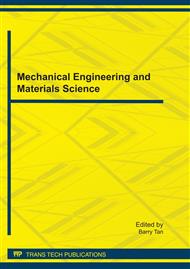[1]
G.K. Elmund, S.M. Morrison, D.W. Grant, M.P. Nevins, Role of excreted chlortetracycline in modifying the decomposition process in feedlot waste, Bull. Environ. Contam. Toxicol. 1971, 6, 129-132.
DOI: 10.1007/bf01540093
Google Scholar
[2]
G. Hamscher, A. Abu-Quare, S. Sczesny, H. Hoper, H. Nau. Determination of tetracyclines and tylosin in soil and water samples from agricultural areas in Lower Saxony, in: L.A. van Ginkel, A. Ruiter (Eds. ), Proceedings of the Euroside IV Conference, National Institute of Public Health and the Environment (RIVM), Bilthoven, Netherlands, 2000, pp.522-526.
Google Scholar
[3]
X.J. Xie, Q.X. Zhou, Z.C. He, Y.Y. Bao, Physiological and potential genetic toxicity of chlortetracycline as an emerging pollutant in wheat (Tritium aestivum L. ), Environ. Toxicol. Chem. 2010, 29, 922-928.
DOI: 10.1002/etc.79
Google Scholar
[4]
US Department of Agriculture Economic Research Service (USDAERS). Agricultural chemicals and production technology: nutrient management. 2006, 16, http: /www. ers. usda. gov/briefing/AgChemicals/nutrientmangement.
Google Scholar
[5]
S.R. Sturzenbaum, P. Kille, A.J. Morgan,. Heavy metal-induced molecular responses in the earthworm, Lumbricus rubellus: genetic fingerprinting by directed differential display, Appl. Soil Ecol. 1998a, 9, 495-500.
DOI: 10.1016/s0929-1393(98)00111-5
Google Scholar
[6]
F. Bernard, F. Brulle, F. Douay, S. Lemiere, S. Demuynck, F. Vandenbulcke, Metallic trace element body burdens and gene expression analysis of biomarker candidates in Eisenia fetida, using an exposure/depuration experimental scheme with field soils, Ecotoxicol. Environ. Saf. 2010, 73, 1034-1045.
DOI: 10.1016/j.ecoenv.2010.01.010
Google Scholar
[7]
H.J. Ricketts, A.J. Morgan, D.J. Spurgeon, P. Kille, Measurement of annetocin gene expression: a new reproductive biomarker in earthworm ecotoxicology, Ecotoxicol. Environ. Saf. 2004, 57, 4-10.
DOI: 10.1016/j.ecoenv.2003.08.008
Google Scholar
[8]
Y.G. Xue, X.Y. Gu, X.R. Wang, C. Sun, X.H. Xu, J. Sun, B.G. Zhang, The hydroxyl radical generation and oxidative stress for the earthworm Eisenia fetida exposed to tetrabromobisphenol A, Ecotoxicology. 2009, 18, 693-699.
DOI: 10.1007/s10646-009-0333-2
Google Scholar
[9]
F. Corpet, Multiple sequence alignment with hierarchical clustering, Nucleic Acids Res. 1998, 16, 10881-10890.
DOI: 10.1093/nar/16.22.10881
Google Scholar
[10]
J.D. Thompson, D.G. Higgins, T.J. Gibson, CLUSTAL W: improving the sensitivity of progressive multiple sequence alignment throught sequence weighting, positions-specific gap penalties and weight matrix choice, Nucleic Acids Res. 1994, 22, 4673-4680.
DOI: 10.1093/nar/22.22.4673
Google Scholar
[11]
T.M. Rose, E.R. Schultz, J.G. Henikoff, S. Pietrokovski, C.M. McCallum, S. Henikov, "Consensus-degenerate hybrid oligonucleotide primers for amplification of distantly related sequences. Nucleic Acids Res. 1998, 26, 1628-1635.
DOI: 10.1093/nar/26.7.1628
Google Scholar
[12]
F. Brulle, A.J. Morgan, C. Cocquerelle, F. Vandenbulcke, Transcriptomic underpinning of toxicant-mediated physiological function alterations in three terrestrial invertebrate taxa: A review, Environ. Pollu. 2010, 158, 2793-3808.
DOI: 10.1016/j.envpol.2010.06.019
Google Scholar
[13]
K.J. Livak, T.D. Schmittgen, Analysis of relative gene expression data using realtime quantitative PCR and the 2(-Delta Delta C(T) method, Methods. 2001, 25, 402-408.
DOI: 10.1006/meth.2001.1262
Google Scholar
[14]
B. Nota, M. Bosse, B. Ylstra, N.M. Straalen, D. Roelofs, Transcriptomics reveals extensive inducible biotransformation in the soil-dwelling invertebrate Folsomia candida exposed to phenanthrene, BMC Genomics 2009, 10, 236-249.
DOI: 10.1186/1471-2164-10-236
Google Scholar
[15]
D.S. Lin, Q.X. Zhou, X.J. Xie, Y. Liu, Potential biochemical and genetic toxicity of triclosan as an emerging pollutant on earthworms (Eisenia fetida), Chemosphere, 2010, 81, 1328-1333.
DOI: 10.1016/j.chemosphere.2010.08.027
Google Scholar
[16]
P.J. Brown, S.M. Long, D.J. Spurgeon, C. Svendsen, P.K. Hankard, Toxicological and biochemical responses of the earthworm Lumbricus rubellus to pyrene, a non-carcinogenic polycyclic aromatic hydrocarbon, Chemosphere 2004, 57, 1675-1681.
DOI: 10.1016/j.chemosphere.2004.05.041
Google Scholar
[17]
A. Bigot, P. Vasseur, F. Rodius, SOD and CAT cDNA cloning, and expression pattern of detoxification genes in the reshwater bivalve Unio tumidus transplanted into the moselle river, Ecotoxicology, 2010, 19, 369-376.
DOI: 10.1007/s10646-009-0419-x
Google Scholar
[18]
P. Gong, N. Basu, A.M. Scheuhammer, E.J. Perkins, Neurochemical and electrophysiological diagnosis of reversible neurotoxicity in earthworms exposed to sublethal concentrations of CL-20, Environ Sci Pollut Res. 2010, 17, 181-186.
DOI: 10.1007/s11356-009-0117-5
Google Scholar
[19]
A.M. Lescure, D. Proudhon, H. Peser, M. Ragland, E.C. Theil, J.F. Briat, Ferritin gene transcription is regulated by iron in soybean cell cultures, Proc. Natl. Acad. Sci. 1991, 88, 8222-8226.
DOI: 10.1073/pnas.88.18.8222
Google Scholar
[20]
S. Lewis, R.D. Handy, B. Cordi, Z. Billinghurst, M.H. Depledge, Stress proteins (HSP's): methods of detection and their use as an environmental biomarker, Ecotoxicology 1999, 8, 351-368.
DOI: 10.1023/a:1008982421299
Google Scholar
[21]
D. Nadeau, S. Corneau, I. Plante, G. Morrow, R.M. Tanguay, Evaluation for Hsp70 as a biomarker of effect of pollutants on the earthworm Lumbricus terrestris, Cell Stress Chaperones 2001, 6, 153-163.
DOI: 10.1379/1466-1268(2001)006<0153:efhaab>2.0.co;2
Google Scholar
[22]
Y.R. Liu, Y.M. Zheng, L.M. Zhang, Y.X. Luan, J.Z. He, Effects of mercury on reproduction, avoidance, and heat shock protein gene expression of the soil springtail folsomia candida, Environ. Toxicol. Chem. 2009, 29, 654-659.
DOI: 10.1002/etc.59
Google Scholar


